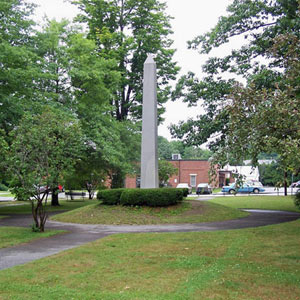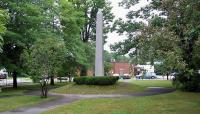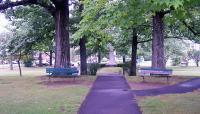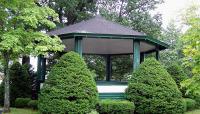Landscape Information
In 1802, 47 men of various religions formed a society to build a public and religious meetinghouse in the town center, facing land donated for a common. When Farmington became the Franklin County seat in 1838, the society deeded the meetinghouse for use as a temporary courthouse and for continued town business. By the 1840s, rows of maples bordered the adjacent common, followed by a bandstand added in 1874. Shortly before 1884, the meetinghouse was moved and the brick Franklin County Courthouse was built in its place. After an 1886 fire destroyed much of the central village, the common was an eyesore for several decades, as it was used to graze animals, store lumber, and stockpile personal property.
In 1903 wealthy sawmill owner George Ranger offered to donate a Civil War monument if the town paid to beautify the common. Citizens voted to spend several hundred dollars for concrete walks, fencing, seats, and granite steps that led to an upper terrace. The shaft monument, a copy of a Maine monument at Gettysburg, was built on a mound at the intersection of four paths. A new bandstand and an iron trough for watering horses were added. The World War II Honor Roll was added in 1945.
The courthouse was listed on the National Register of Historic Places in 1983, and the park in the foreground retains much of its historic integrity. The terraces, granite steps, and Civil War monument remain. The iron rail fence and watering trough are rare examples of their age and type, statewide. The bandstand’s style is the best of its era in Franklin County. Concrete sidewalks remain along the park’s perimeter; with the park’s popularity and heavy use, interior sidewalks have been widened and changed to asphalt. A freedom monument was added in the early 2000s.







